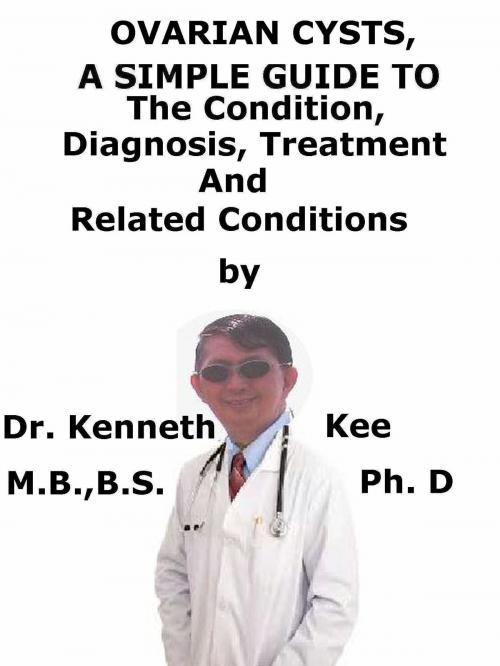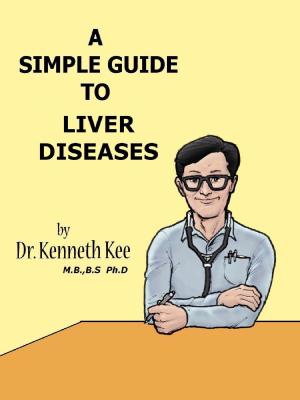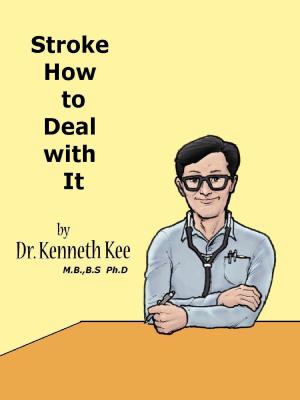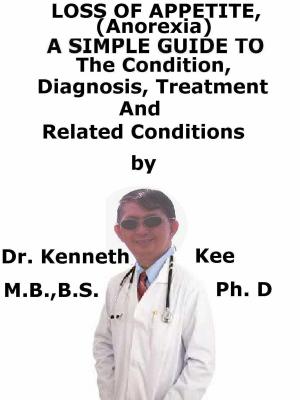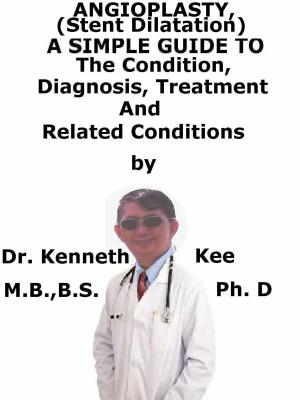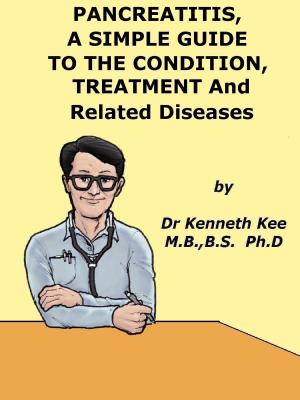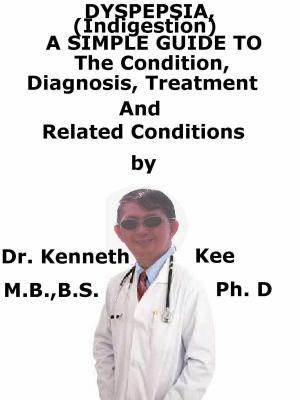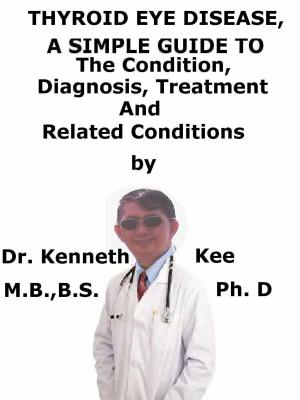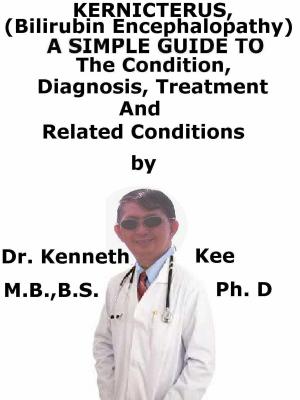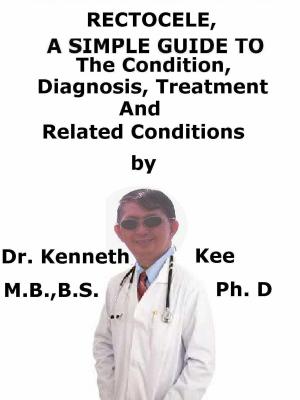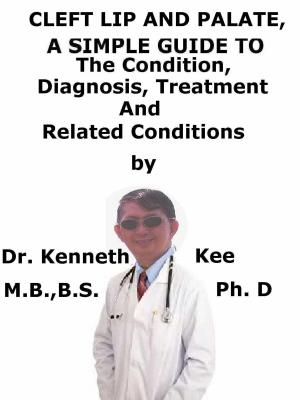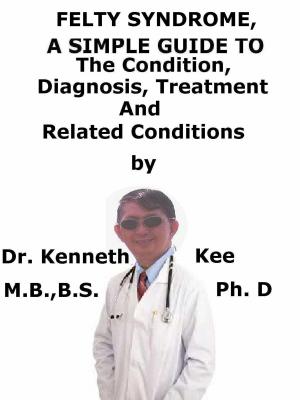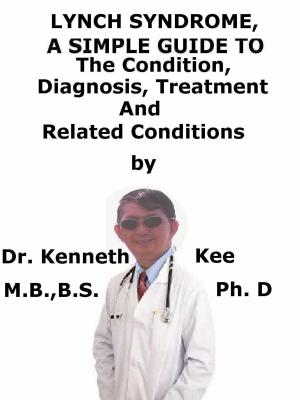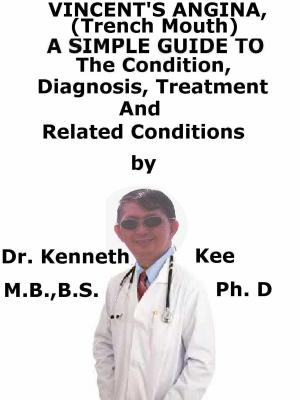Ovarian Cysts, A Simple Guide To The Condition, Diagnosis, Treatment And Related Conditions
Nonfiction, Health & Well Being, Medical, Specialties, Gynecology & Obstetrics, Health, Women&| Author: | Kenneth Kee | ISBN: | 9781370205073 |
| Publisher: | Kenneth Kee | Publication: | July 15, 2017 |
| Imprint: | Smashwords Edition | Language: | English |
| Author: | Kenneth Kee |
| ISBN: | 9781370205073 |
| Publisher: | Kenneth Kee |
| Publication: | July 15, 2017 |
| Imprint: | Smashwords Edition |
| Language: | English |
An ovarian cyst is a sac filled with fluid or semi-fluid that forms on or inside an ovary.
Ovarian cysts or tumors can be divided into three main groups:
1. Functional (24%)
They form as a result of enlargement of the follicular cyst that contained the ovum during the menstrual cycle.
2. Benign epithelial neoplastic cysts (70% of ovarian cysts)
a. Serous cystadenoma:
b. Mucinous cystadenoma:
c. Benign neoplastic cystic tumors of germ cell origin
d. Benign cystic teratoma; rarely malignant.
3. Malignant (6%)
Causes:
Each month during the menstrual cycle, a follicle grows on the ovary.
The follicle is where an egg is developing.
Most months, an egg is released from this follicle, called ovulation.
If the follicle does not break open and release an egg, the fluid remains in the follicle and develops a cyst.
This is called a follicular cyst.
Another type of cyst occurs after an egg has been released from a follicle.
This is called a corpus luteum cyst.
These functional ovarian cysts tend to be more frequent in the childbearing age between puberty and menopause.
The disorder is less frequent after menopause.
Taking fertility drugs can cause a disorder in which multiple large cysts are formed on the ovaries.
This is called ovarian hyper-stimulation syndrome.
The cysts most often go away after a woman's period, or after a pregnancy.
Benign neoplastic cystic tumors of germ cell origin are most frequent in young women.
They are responsible for 15-20% of all ovarian neoplasms.
Risk factors
1. Obesity.
2. Tamoxifen therapy has been linked with a rise in persistent ovarian cysts.
3. Early menarche.
4. Infertility.
5. Dermoid cysts can be inherited in families
Symptoms
Ovarian cysts often produce no symptoms but are found by chance on bimanual examination or ultrasound
There is dull ache or pain in the lower abdomen and low back pain.
Ovarian torsion or rupture may result in severe abdominal pain and fever.
Symptoms of ovarian cysts can also be:
1. Bloating or swelling in the abdomen (Swollen abdomen, with palpable mass arising out of the pelvis, which is dull to percussion and does not go away if the bladder is emptied)
2. Pain during bowel movements
3. Pain in the pelvis shortly before or after beginning a menstrual period
4. Pain with intercourse (dyspareunia ) or pelvic pain during movement
5. Pelvic pain that is constant, dull aching
6. Sudden and severe pelvic pain, often with nausea and vomiting, may be a sign of torsion or twisting of the ovary on its blood supply, or rupture of an ovarian cyst with internal bleeding
Diagnosis:
Ultrasound may be used to diagnose a cyst.
A pelvic ultrasound is the single most efficient way of assessing an ovarian mass.
Transvaginal ultrasonography is favored due to its higher sensitivity over transabdominal ultrasound.
Blood test:
1. Ca-125 test, to look for possible cancer if the patient has an abnormal ultrasound or are in or past menopause
2. Hormone levels (such as LH, FSH, estradiol, and testosterone)
3. Pregnancy test (Serum HCG) - uterine or ectopic pregnancy
4. FBC - infection, hemorrhage.
5. Urinalysis - if there are urinary symptoms.
Treatment
Functional ovarian cysts often do not require treatment.
They often disappear on their own within 8 to 12 weeks.
In the past, the doctor may give to women birth control pills.
These medicines have not been found effective and are now not used.
Surgery
If conservative measures do not succeed or if criteria for surgery are met, surgical treatment for benign ovarian cysts or tumors is normally very effective and provides a cure with minimal effect on reproductive ability.
Laparoscopic surgery for benign ovarian tumors is normally preferred to open surgery.
TABLE OF CONTENT
Introduction
Chapter 1 Ovarian Cyst
Chapter 2 Causes
Chapter 3 Symptoms
Chapter 4 Diagnosis
Chapter 5 Treatment
Chapter 6 Prognosis
Chapter 7 Polycystic Ovary Syndrome
Chapter 8 Ovarian Torsion
Epilogue
An ovarian cyst is a sac filled with fluid or semi-fluid that forms on or inside an ovary.
Ovarian cysts or tumors can be divided into three main groups:
1. Functional (24%)
They form as a result of enlargement of the follicular cyst that contained the ovum during the menstrual cycle.
2. Benign epithelial neoplastic cysts (70% of ovarian cysts)
a. Serous cystadenoma:
b. Mucinous cystadenoma:
c. Benign neoplastic cystic tumors of germ cell origin
d. Benign cystic teratoma; rarely malignant.
3. Malignant (6%)
Causes:
Each month during the menstrual cycle, a follicle grows on the ovary.
The follicle is where an egg is developing.
Most months, an egg is released from this follicle, called ovulation.
If the follicle does not break open and release an egg, the fluid remains in the follicle and develops a cyst.
This is called a follicular cyst.
Another type of cyst occurs after an egg has been released from a follicle.
This is called a corpus luteum cyst.
These functional ovarian cysts tend to be more frequent in the childbearing age between puberty and menopause.
The disorder is less frequent after menopause.
Taking fertility drugs can cause a disorder in which multiple large cysts are formed on the ovaries.
This is called ovarian hyper-stimulation syndrome.
The cysts most often go away after a woman's period, or after a pregnancy.
Benign neoplastic cystic tumors of germ cell origin are most frequent in young women.
They are responsible for 15-20% of all ovarian neoplasms.
Risk factors
1. Obesity.
2. Tamoxifen therapy has been linked with a rise in persistent ovarian cysts.
3. Early menarche.
4. Infertility.
5. Dermoid cysts can be inherited in families
Symptoms
Ovarian cysts often produce no symptoms but are found by chance on bimanual examination or ultrasound
There is dull ache or pain in the lower abdomen and low back pain.
Ovarian torsion or rupture may result in severe abdominal pain and fever.
Symptoms of ovarian cysts can also be:
1. Bloating or swelling in the abdomen (Swollen abdomen, with palpable mass arising out of the pelvis, which is dull to percussion and does not go away if the bladder is emptied)
2. Pain during bowel movements
3. Pain in the pelvis shortly before or after beginning a menstrual period
4. Pain with intercourse (dyspareunia ) or pelvic pain during movement
5. Pelvic pain that is constant, dull aching
6. Sudden and severe pelvic pain, often with nausea and vomiting, may be a sign of torsion or twisting of the ovary on its blood supply, or rupture of an ovarian cyst with internal bleeding
Diagnosis:
Ultrasound may be used to diagnose a cyst.
A pelvic ultrasound is the single most efficient way of assessing an ovarian mass.
Transvaginal ultrasonography is favored due to its higher sensitivity over transabdominal ultrasound.
Blood test:
1. Ca-125 test, to look for possible cancer if the patient has an abnormal ultrasound or are in or past menopause
2. Hormone levels (such as LH, FSH, estradiol, and testosterone)
3. Pregnancy test (Serum HCG) - uterine or ectopic pregnancy
4. FBC - infection, hemorrhage.
5. Urinalysis - if there are urinary symptoms.
Treatment
Functional ovarian cysts often do not require treatment.
They often disappear on their own within 8 to 12 weeks.
In the past, the doctor may give to women birth control pills.
These medicines have not been found effective and are now not used.
Surgery
If conservative measures do not succeed or if criteria for surgery are met, surgical treatment for benign ovarian cysts or tumors is normally very effective and provides a cure with minimal effect on reproductive ability.
Laparoscopic surgery for benign ovarian tumors is normally preferred to open surgery.
TABLE OF CONTENT
Introduction
Chapter 1 Ovarian Cyst
Chapter 2 Causes
Chapter 3 Symptoms
Chapter 4 Diagnosis
Chapter 5 Treatment
Chapter 6 Prognosis
Chapter 7 Polycystic Ovary Syndrome
Chapter 8 Ovarian Torsion
Epilogue
